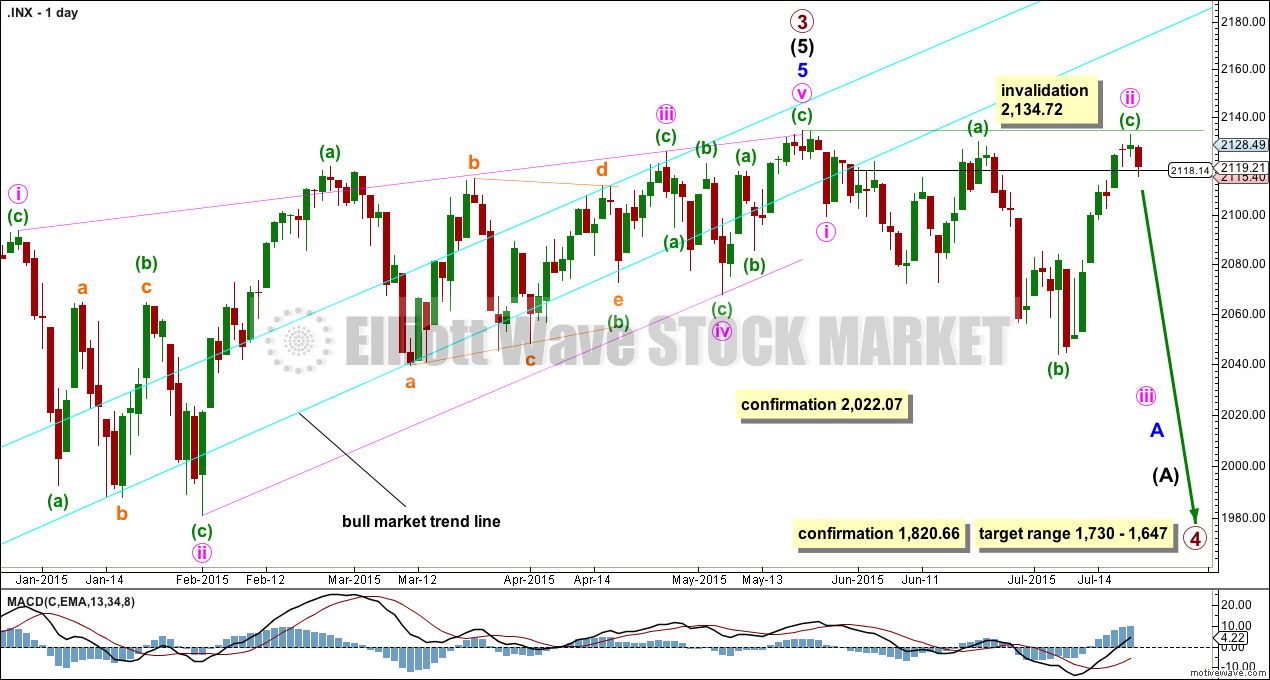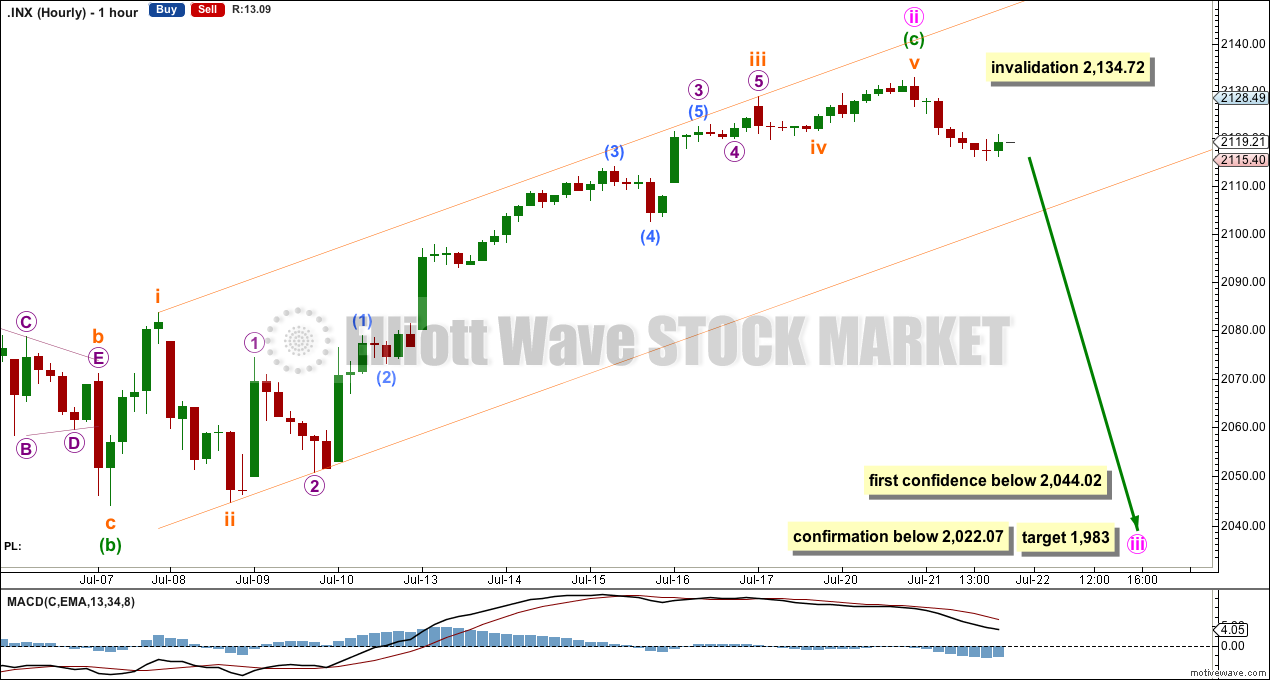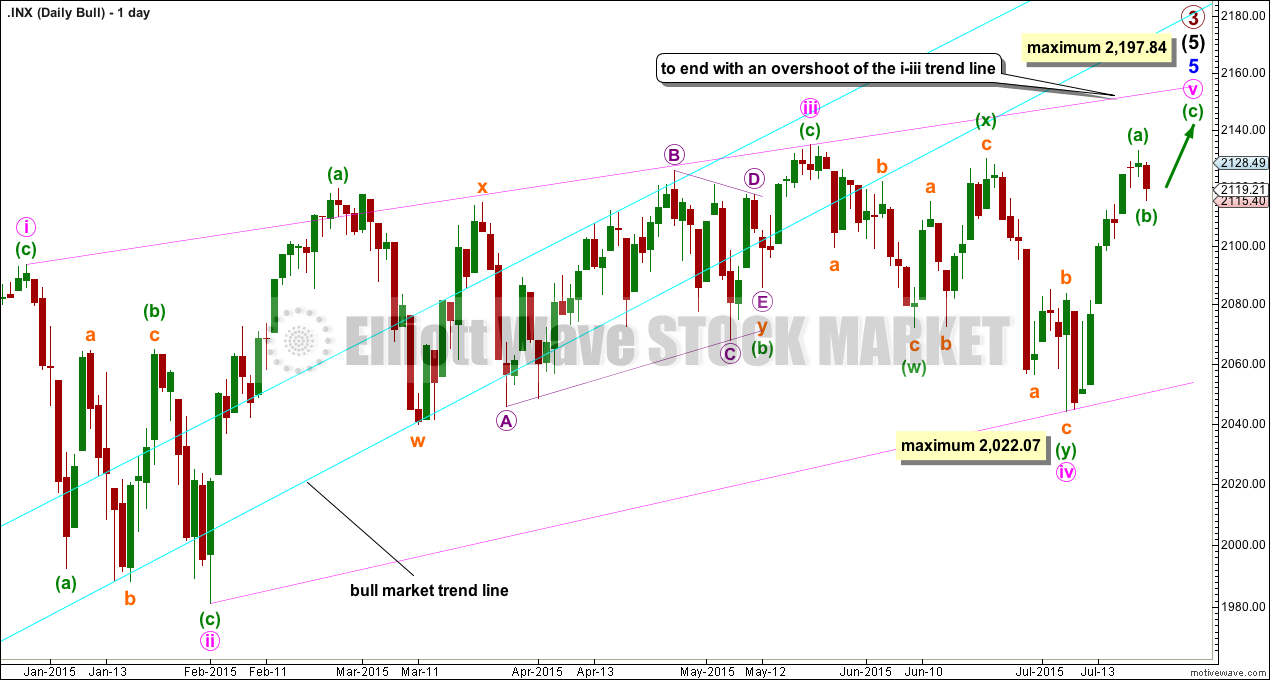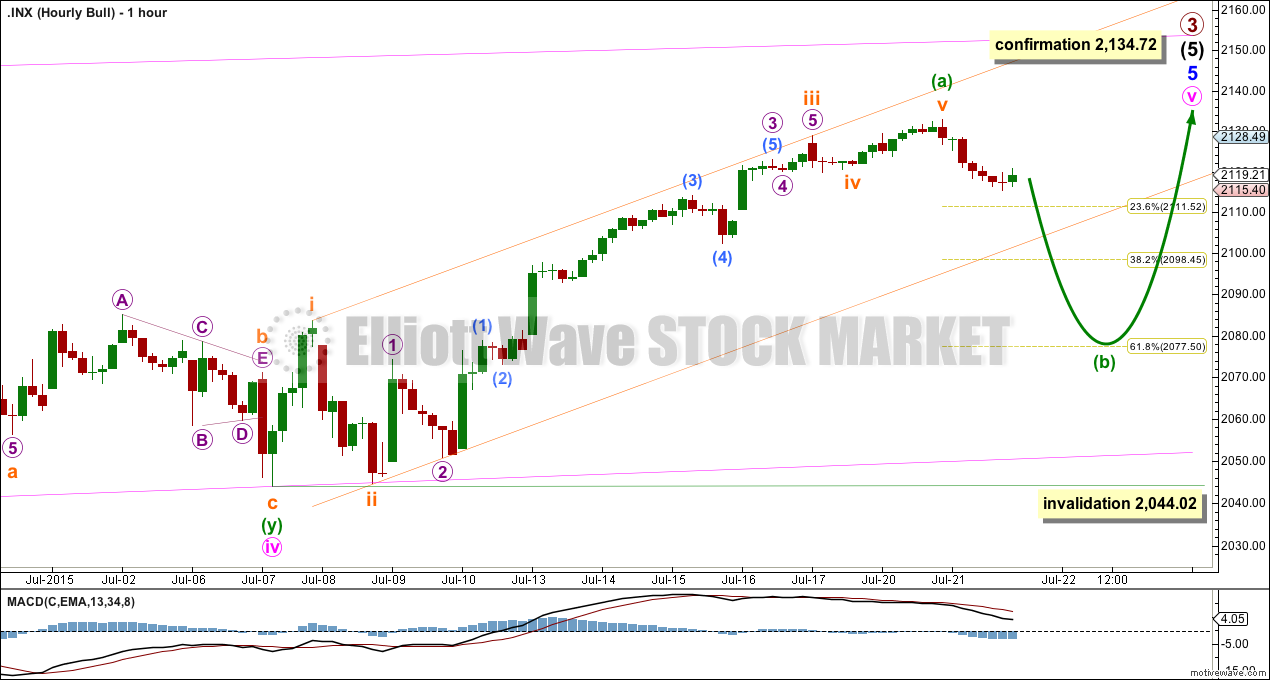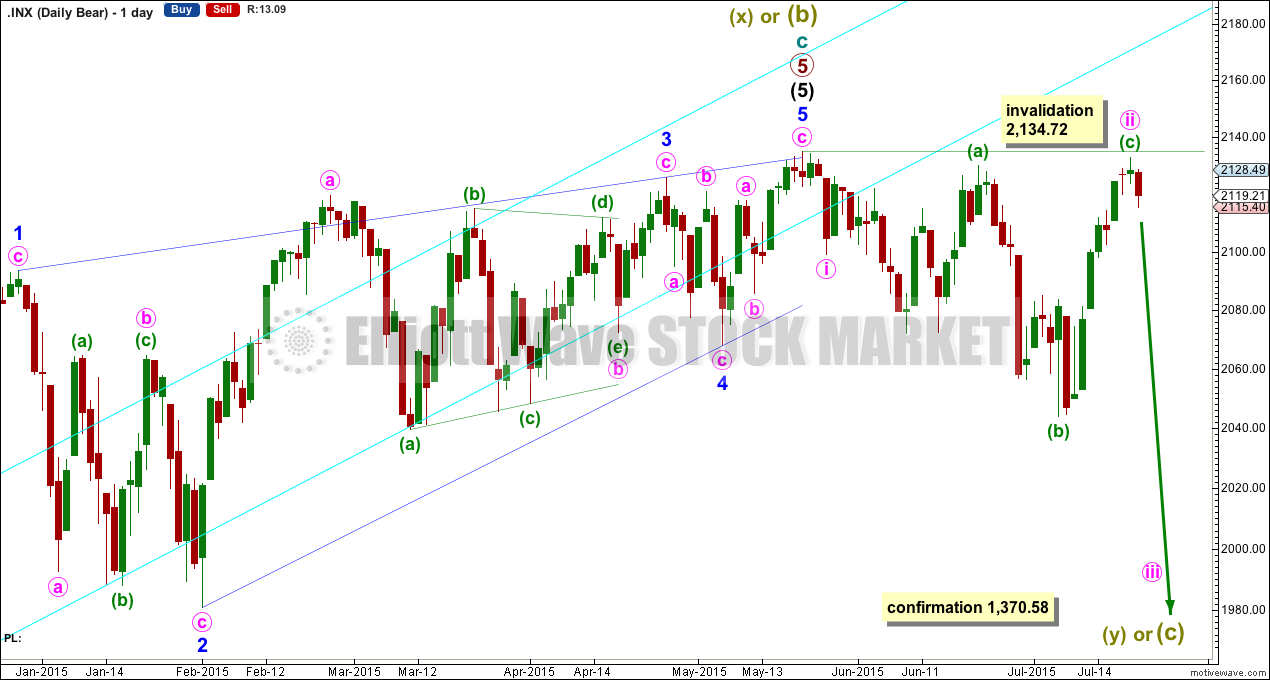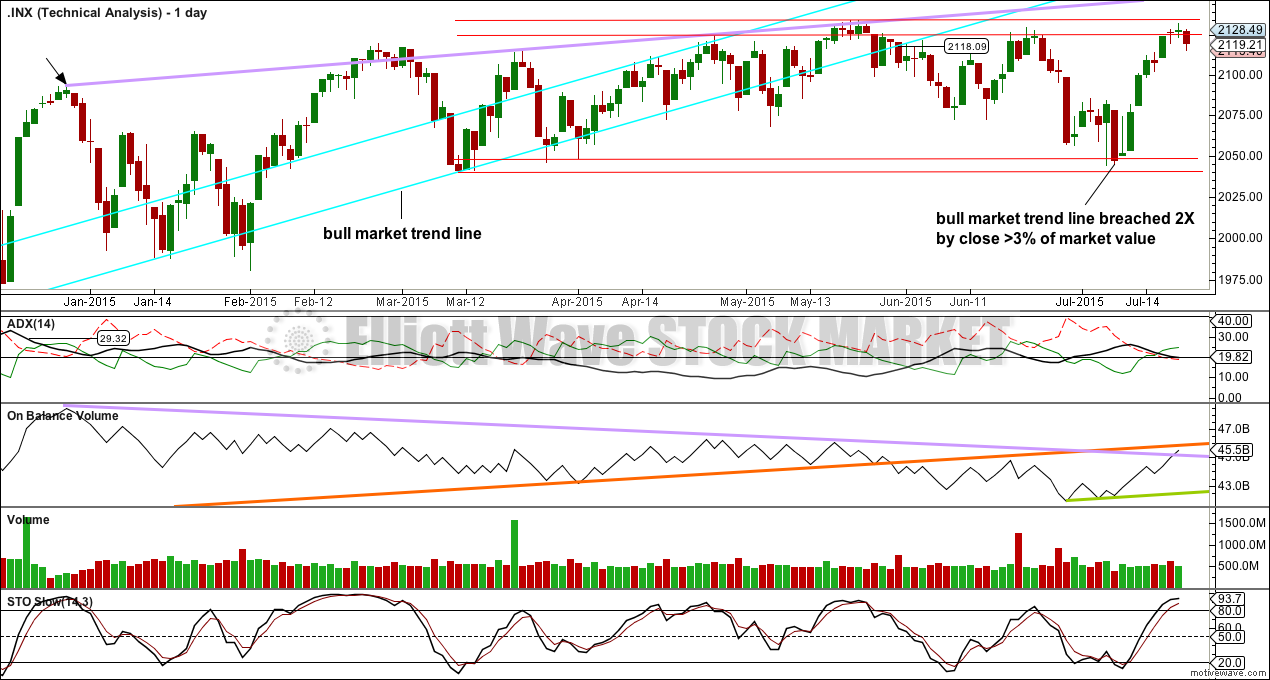I have two Elliott wave counts today, with additional regular technical analysis that aims to see which Elliott wave count is more likely.
Summary: A new low below 2,044.02 now would provide a lot of confidence in the first wave count, the target would be at 1,983. A new all time high above 2,134.72 would provide full confidence in the second wave count which expects new all time highs. In the short term, for both wave counts, more downward movement is expected.
Changes to last analysis are bold.
To see a weekly chart and how to draw trend lines click here.
FIRST ELLIOTT WAVE COUNT
It is possible that the S&P has seen a primary degree (or for the bear count below a Super Cycle degree) trend change.
This wave count now has some confirmation at the daily chart level with a close more than 3% of market value below the long held bull market trend line.
Further confirmation would come with:
1. A new low below 2,044.02.
2. A new low below 2,022.07 to invalidate the alternate wave count.
3. A clear five down on the hourly chart.
4. A clear five down on the daily chart.
5. A new low below 1,820.66.
6. A break below the 50 day SMA on the weekly chart.
As each condition is met the probability of a substantial trend change would increase.
At this stage, a trend change is looking somewhat likely so I’ll list points in its favour:
1. The long held bull market trend line, the strongest piece of technical analysis on ALL charts, has been breached now by a close more than 3% of market value.
2. There is quadruple negative divergence between price and MACD on the weekly chart.
3. There is double negative divergence between price and MACD on the daily chart.
4. There is persistent and strong negative divergence between price and RSI on the monthly chart. The last time this happened was October 2007 and we all know what happened after that…
5. A long held bull trend line on On Balance Volume going back to October 2014 has been breached and is no longer providing support (orange line added to OBV on the TA chart below). It may provide resistance.
6. DJT has recently failed to confirm the continuation of a bull market. This does not indicate a bear market, but does indicate caution.
Primary wave 4 would be likely to end within the price territory of the fourth wave of one lesser degree: intermediate wave (4) has its price territory from 1,730 to 1,647.
Primary wave 4 would be likely to exhibit alternation to primary wave 2. Primary wave 2 was a 0.41 zigzag correction lasting 12 weeks, one short of a Fibonacci 13. Primary wave 4 may be more shallow than the 0.382 Fibonacci ratio, and may be a flat, combination or triangle, which are more time consuming structures than zigzags so it should be longer in duration than primary wave 2. Primary wave 4 may last a Fibonacci 21 weeks in total, 1.618 the duration of primary wave 2.
The only option now for this wave count is to see minute wave ii as a very deep expanded flat correction. However, it looks out of proportion to minute wave i.
Minute wave ii must be over here. There is almost no room left for it to move up into, and within it, all subdivisions are complete.
There is no Fibonacci ratio between minuette waves (a) and (c). Within minuette wave (c), there are no Fibonacci ratios between subminuette waves i, iii and v.
This wave count is still viable. Second wave corrections are often very deep, and may be up to 100% of the first wave. Only a new high above 2,134.72 would invalidate this wave count. Minute wave ii may not move beyond the start of minute wave i above 2,134.72.
At 1,983 minute wave iii would reach 4.236 the length of minute wave i.
Draw a channel about minuette wave (c) using Elliott’s first technique as shown. Along the way down, the lower edge may provide support and when that orange line is breached it may then provide resistance.
With some adjustment for the second wave count at the hourly chart level, the confirmation point for this first wave count must now be at 2,044.02. Before we get to that point, downward momentum and structure may indicate which wave count is more likely. This wave count expects a third wave down while the second wave count below expects a B wave down. Third waves should show strong momentum and may only subdivide as impulses while B waves must subdivide as corrective structures and don’t normally show strong momentum.
SECOND ELLIOTT WAVE COUNT
The ending contracting diagonal may still be incomplete. Ending diagonals require all sub waves to subdivide as zigzags, and the fourth wave should overlap first wave price territory. It is Elliott wave convention to always draw the diagonal trend lines to indicate a diagonal structure is expected.
My labelling here of minute wave iv within the diagonal as a double zigzag relies upon the interpretation of “double and triple zigzags take the place of zigzags” (“Elliott Wave Principle” by Frost and Prechter, 10th edition, page 91) to be true for zigzags within diagonals. This wave down may also be labelled as a single zigzag, but that does not have as neat a fit as a double zigzag.
The diagonal trend lines are no longer clearly contracting. This reduces the probability of this wave count.
If it moves any lower, then minute wave iv may not be longer than equality in length with minute wave ii at 2,022.07. If it is over here, then minute wave v up also has a limit and may not be longer than equality with minute wave iii at 2,197.84.
The best way to see where and when upwards movement may end is the upper diagonal i-iii trend line. It is very likely to be overshot. Upwards movement may find resistance at the long held bull market trend line.
I am adjusting the labelling within minute wave v to be in line with the first wave count. This upwards movement fits best and looks like a completed impulse. It may have been minuette wave (a) within the zigzag of minute wave v.
Minuette wave (b) may not move beyond the start of minuette wave (a) below 2,044.02.
Minuette wave (b) should breach the channel drawn here about minuette wave (a). This channel is drawn in the same way on both hourly wave counts.
Minuette wave (b) must subdivide as a corrective structure, and may end close to either the 0.382 or 0.618 Fibonacci ratios of minuette wave (a) at either 2,098 or 2,078. Lasting a few days, minuette wave (b) should show up as a clear three on the daily chart, and is most likely to be choppy and overlapping, a typical sideways consolidation, and may be a quick sharp zigzag. Of all Elliott waves, it is B waves which exhibit the greatest variety in form and structure; there are more than thirteen possible corrective structures this B wave may take.
When minuette wave (b) is over, then a target for minuette wave (c) upwards to complete the zigzag of minute wave v may be calculated.
BEAR ELLIOTT WAVE COUNT
The subdivisions within cycle waves a-b-c are seen in absolutely exactly the same way as primary waves 1-2-3 for the main wave count.
In line with recent Grand Super Cycle wave analysis, I have moved the degree of labelling for the bear wave count all up one degree.
This bear wave count expects a Super Cycle wave (c) to unfold downwards for a few years, and if it is a C wave it may be devastating. It may end well below 666.79.
However, if this wave down is a Super Cycle wave (y), then it may be a time consuming repeat of the last big flat correction with two market crashes within it, equivalent to the DotCom crash and the recent Global Financial Crisis, and it may take another 8-9 years to unfold sideways.
Within the new bear market, no second wave correction may move beyond the start of its first wave above 2,134.72.
The second wave count above works in the same way for this bear wave count.
TECHNICAL ANALYSIS
ADX is now below 20 and declining. No clear trend is indicated. A sideways range bound trading system would be better employed at this time than a trend following system.
At any one time a market will be doing only one of two things: either trending or consolidating. Your trading system / approach should be different for each type of market. Profiting in a clearly trending market is easier and involves less risk. Profiting in a consolidating market is harder and involves higher risk; only experienced professionals normally are able to profit in this kind of market. Good money management and careful stops are essential during consolidation to avoid wiping out your account.
One possible range bound trading system is presented here. It is very simple, and simple is usually best. This approach uses horizontal lines (red) of support and resistance in conjunction with Slow Stochastics. The idea is that when price reaches support or resistance at the same time Stochastics reaches oversold or overbought a trend change should be expected. The risk comes with the ability of price to move beyond the outer lines of support and resistance before turning around. This approach should tell us about where and when price may turn, but it cannot tell exactly where and when price will turn.
Eventually, the market will move again from consolidation to trending, and when that happens ADX is often slow to indicate the change. Eventually, the final swing expected from this range bound system will never come and that is when the breakout will happen. But at that point in time this system may expect a trend change which will never come. This is another illustration of why trading a consolidating market is so risky and has the potential for big losses. Stops are vital.
At this stage, price has reached up into the zone of resistance and so far looks like it may be turning down. If Stochastics data (when it is seen) also shows a return from oversold, then a downward swing should be expected to begin from here.
This regular technical analysis supports the Elliott wave counts at least in the short term.
Tuesday’s session sees a small increase in volume for a down day beyond the prior up day. Volume continues to indicate a downward breakout is more likely than upward. However, the prior high (arrow) of 26th December, 2014, came on declining volume and was followed by five days down on increasing volume. This is exactly the opposite of what is normal and what should be expected, and illustrates that volume behaviour at the moment for the S&P 500 may not be normal making volume analysis less reliable.
On Balance Volume may be a better volume analysis tool at this time. OBV may be finding resistance at the long held orange trend line, which supports the idea of a downward swing from here, at least in the short term.
A note on Dow Theory: for the bear wave count I would wait for Dow Theory to confirm a huge market crash. For that to be confirmed the following new lows are needed:
S&P500: 1,820.66
Nasdaq: 4,116.60
DJT: 7,700.49
DJIA: 15,855.12
At this time DJT is closest, but none of these indices have made new major swing lows yet.
This analysis is published about 08:12 p.m. EST.

